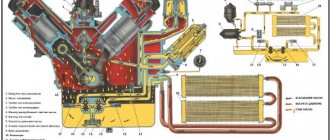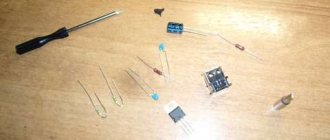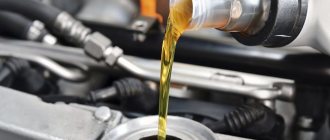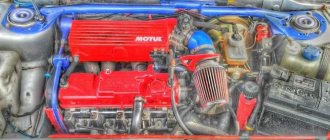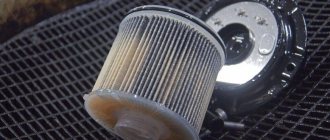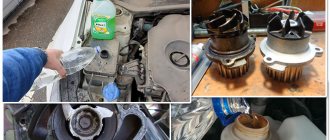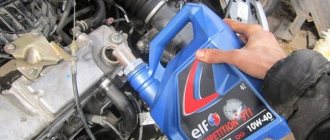Action
High-Gear sealant stops leaks that form through:
- Valve cover gaskets.
- Oil pan
- Timing chain cover.
- Rough, worn crankshaft and camshaft seals.
The effect does not occur instantly, but after approximately 500-800 km. It depends on the degree of wear. But in just one application the elasticity and size of gaskets and seals returns to normal.
Application
The instructions for using this product are simple. To stop a leak in the engine, the product is poured into it. The engine must first be warmed up and stopped. Shake the product. Fill at the rate of 1 package per 4-5 liters of engine oil. The leak will stop after 500-800 km.
For repairs in manual transmissions, the product is poured in a ratio of 1:5 with gear oil. The ventilation breather should be cleaned first. You must drive until the leak stops. Then change the oil.
How to choose a sealant for a car
To understand how to choose a sealant for a car, you need to understand its application and the most important parameters:
- Kinds
. There are 3 types.
- Silicone. The most versatile, suitable for gluing any materials. Widely used for sealing seals and gaskets or replacing them completely. Has a wide temperature range. Polymerizes under the influence of moisture in the air.
- Polyurethane. Sticks to any surface. It is used for sealing body parts and other parts, except the engine, since they are not heat-resistant compared to silicone options.
- Anaerobic. Polymerization occurs in the absence of oxygen. Such substances are good for sealing small cracks in the cooling system, and they are added directly to the coolant.
Top sealants for cars
- Temperature
. If you don’t know which sealant is best to choose for your car, give preference to the one with the highest operating temperature limits. The car can get very cold in winter, especially in the north. Engine components can become very hot during operation. This also applies to body parts that can be heated by the sun. - Chemical resistance
. A good sealant should not be exposed to chemicals common in car operation, including aggressive ones. These include various fuels, brake fluid, engine and transmission oils, grease, antifreeze, and water. - Load and vibration tolerance
. It is correct if the hardened sealant easily withstands even strong impacts. Otherwise, it will quickly crack and crumble. In solid form, the product should remain elastic. - Ease of use
. An important factor determining the choice of packaging. It should provide ease of application. As a rule, tubes or cylinders are used. Polyurethane products can be packaged for use with guns. It is better to take a small package - the shelf life of sealants is limited to 1-2 years. - Color
. Most manufacturers adhere to the following range: red (heat resistant), black (oil resistant), blue (water resistant), gray (high strength). However, this rule is not always used. - The best manufacturers
. We advise you to choose products from reputable brands and try not to buy fakes. The best brands: ABRO, LIQUI MOLY, Done Deal, PERMATEX, Lavr, KERRY, Mannol, ASTROhim, Victor Reinz, Dirko, CYCLO, Curil.
Purpose of sealant
Sealant for the engine oil pan is a special composition to prevent lubricant leaks, a paste or gel-like mass with a high viscosity index that can fill cracks. This product extends the life of gaskets or allows you to replace elastic elements, stops leaks through the valve cover holes, and eliminates leaks in the radiator and other parts of the engine oil system.
Anaerobic
Anaerobic engine sealant belongs to the group of acrylic adhesives. Resistant to vibration loads, temperature fluctuations and pressure changes, resistant to aggressive chemical components. The sealant prevents the formation of corrosion and stops the oxidation process. It contains the following components: acrylic oligomers, thickeners, inhibitors, etc.
The material hardens when interacting with metal in places (gaps and cracks) where oxygen does not enter. In order for the anaerobic auto sealant to polymerize, the parts must be tightly connected.
This property is an advantage of the sealing composition, since it gives a large amount of time to work. The driver or technical center specialist can carry out repair work carefully and without haste, without worrying about the rapid hardening of the material. The average setting time is 20-30 minutes.
Anaerobic sealant has disadvantages. This chemical is not suitable for creating a thick seal layer or filling large gaps and cracks.
Silicone
Silicone automotive sealants are highly elastic and durable, heat-resistant, and have a long service life. Suitable for minor repairs and solving more serious problems. They consist of a polymer base, a vulcanizer, a plasticizer, a filler to add volume and color, a coupling agent and an amplifier.
The buyer can choose silicone auto sealant for non-professional use. Sealing materials are available for sale, differing in the temperature conditions of use and the elasticity of the resulting layer. For example, you can choose a product that can withstand the increased pressure in boosted turbocharged power units.
Polymerization of a silicone-based chemical is carried out due to the moisture contained in the air. The total setting time is 8-10 minutes. Silicone sealant dries quickly compared to anaerobic sealant. However, this time is enough to repair engine parts, apply lubricant to the valve cover and other elements.
For the use of silicone sealing material to be effective, it is necessary to clean the metal surface from contamination. Then degrease and dry. Only then is oil system sealant applied, which plays the role of a seal and seals off fluid leaks.
For urgent repairs
This engine sump sealant is not directly related to anaerobic-type auto chemicals and silicone-based compounds. It is needed as a temporary remedy for emergency situations. It is poured into the lubrication or cooling system when there is a leak, but there is no way to determine the cause of the problem and quickly eliminate it. Works like liquid gasket for cars. After use, it stops the loss of technical fluid, allowing you to get to the garage or repair shop.
This product is made on the basis of synthetic resins. Has a wide range of applications. It is characterized by high elasticity and increased resistance to ultraviolet radiation, mechanical damage and humidity.
However, repair sealant is rarely used by drivers when sealing the cylinder head gasket and the oil pan of the power unit. The main reason is the lower efficiency of most products compared to narrow-profile anaerobic and silicone compounds.
About acid and neutral sealants
Silicone sealant for cylinder head gaskets and engine oil pan, depending on the chemical composition, can be acidic or neutral. The first one releases acetic acid during polymerization and has a strong smell, the second one releases ketoxime or alcohol (no smell). Acidic sealants are aggressive towards non-ferrous metals. Therefore, they are practically not used in modern foreign cars.
Neutral silicone sealant is less aggressive and has a wider range of applications. At the same time, it has increased adhesion to other materials, resistance to water and UV rays.
Rating of the best automotive sealants
CategoryPlaceNameRatingPrice
| Best Gasket Sealants | 1 | Permatex Ultra Gray | 9.9 / 10 | 600 |
| 2 | Victor Reinz Reinzosil | 9.8 / 10 | 400 | |
| 3 | Liqui Moly Silicon-Dichtmasse Grau | 9.7 / 10 | 650 | |
| The best heat-resistant sealants for cars | 1 | Permatex Ultra Copper | 9.9 / 10 | 500 |
| 2 | Done Deal DD6731 | 9.6 / 10 | 250 | |
| The best anaerobic sealants | 1 | Loctite 574 | 9.7 / 10 | 2 100 |
| 2 | Permatex 51813 | 9.6 / 10 | 790 | |
| The best sealants for the exhaust system | 1 | Liqui Moly Auspuff-Montage-Paste | 9.8 / 10 | 620 |
Steel Seal Blown Head Gasket Fix Repair Sealer
This car engine sealant comes with simple instructions, although it requires little automotive knowledge to use. This product is designed to address a variety of blown head gasket symptoms, which include white smoke, engine overheating, external leaks, and watery oil.
The unique feature of this sealant is that it is designed to seal leaks in older engines in just one application. In addition, this sealant does not contain particles that can accumulate, block the pipes and lead to more problems in the engine. The fluid acts by bonding to cracks, even when exposed to high temperatures, and provides permanent sealing properties. From this product you can expect fast sealing and quality performance on both petrol and diesel engines.
Although this engine gasket sealant is very good, it is quite expensive. There are cheaper options that offer almost the same qualities as this product. However, this sealant is a great choice for people with larger engines, older trucks, and used vehicles.
Head Gasket Fix
This is the best engine sealant from Head Gasket Fix. This sealant prevents leaks using antifreeze-compatible sodium silicate sealant and multiple sealing elements. Fluid technology is designed to repair damaged, leaking and burnt gaskets. It also seals cracked cylinder heads and blocks.
This American company has an excellent reputation, and its first patent for repairing head gasket leaks dates back to 1950. Users report that this product works as described. This is a professional grade engine block sealant that is easy to use.
One disadvantage is that if your heater core has a partial blockage, this sealant may clog it. It is also very thick and can be difficult to use. Also, in many cases, this is just a temporary solution and not a permanent fix (despite its name).
K-Seal ST5516
K-Seal ST5516 HD is a sealant that comes at an affordable price. A distinctive feature of this product is the fact that it is compatible with any antifreeze, which eliminates the need to flush the cooling system before use. This is a multi-functional product and you can safely use a good engine sealant to solve leaking problems associated with the heater core, engine block, water pump housing and plugs.
The formula used to make this product uses a type of nanotechnology that includes microfibers that are cross-linked to seal cracks and leaks. You can see the effect of the sealant within three minutes of application. The product is easy to use and does not require special skills.
If you are dealing with serious damage, you may want to consider a different product. There have been cases where the sealant has discolored some brands of antifreeze products. However, this sealant is a great choice for people looking for an effective yet affordable product.
Permatex
This high tack gasket sealant comes in a variety of sizes and is also sold in aerosol cans. It dries quickly, is very sticky and produces a non-fragile film. The product operates at temperatures ranging from -30 degrees to 260 degrees Celsius. It is resistant to gas, oil, antifreeze, propane and many other substances.
It is an inexpensive, versatile, heat resistant engine sealant with a very long shelf life if properly sealed after each use. The lid has a rod and brush mounted together, making it easy to use. It's great for gaskets. It is also suitable for water pumps, timing chain covers and other applications.
However, it has a very pungent odor. The product is also very messy, and the brush applicator is shorter than the depth of the jar, so it can be difficult to get that last "piece" out, especially after it's dried a bit.
What to use
Automotive manufacturers produce a wide range of sealants. Substances differ in composition and rate of hardening. Which sealant to place the engine sump on is chosen depending on the purpose, versatility and quality of the product.
Sealants of this category are intended for engine lubrication systems; they are poured directly into the engine. The composition does not allow oils to leak out of the engine. One of the most popular products is Hi-Gear 9041 (or 9043) Engine Sealant. Does not come into contact with an aggressive oil environment, restores the elasticity of oil seals and seals, and is suitable for preventive purposes. Hi-Gear engine oil system sealant is compatible with different types of motor oils, the scope of application is gasoline and diesel internal combustion engines.
Metal-ceramic sealant eliminates antifreeze leakage through the cylinder head gasket. You can repair aluminum and cast iron cylinder heads so as not to use welding. It withstands vibrations, shocks, deformations, high temperatures and pressure, and is in normal contact with engine oil and coolant.
Loctite 574
Loctite cylinder head sealant is produced by the famous brand Henkel. It is an anaerobic flange compound that hardens at temperatures between +15 and -25°C. Loctite 574 is used to fix metal surfaces, but access to oxygen must be prevented for complete polymerization of the substance. It is best used for hermetically sealing parts with a minimum technological gap, tightly pulled together.
Dow Corning Q3-1566
The highest quality and most effective American-made product. It is the best sealant for engines and has impeccable heat resistance characteristics - from -70 to +345°C. Scope of application: cylinder head, transmissions, water pumps, manifolds.
The product is resistant to motor oils and does not withstand the effects of antifreeze, water, or lubricants. It has good resistance to vibrations, shocks, deformations, and overheating (but you should not “boil” the engine). The product can be used to prevent internal combustion engine depressurization.
A classic example of good quality at an affordable price. Red (ABRO 11-AB universal engine sealant) - it can be used for almost all power units and components of the car, as an effective sealant. Main advantages:
- The maximum temperature resistance limit is up to +343°C.
- Waterproof, neutral to aggressive environments.
- Good resistance to mechanical stress.
ABRO 11-AB allows you to form a fairly strong elastic layer on the treated surface that can withstand any load.
FÖRCH K157
The FÖRCH K157, K158 and K161 series of motor anaerobes have good characteristics. The substances work effectively under conditions of high temperature extremes and high pressure, when the engine experiences extreme loads. Areas of use: motor flanges, threaded connections.
Among the advantages of FÖRCH sealants are elasticity, adhesion and sealing strength, and chemical resistance. But for the composition to completely harden, it requires exposure to high temperatures from +80 to +100°C. Use strictly for its intended purpose, does not replace the gasket between the cylinder block and the cylinder head.
The brand's silicone sealants, K165-167, have good properties for sealing the engine oil pan. The main characteristics are good adhesion and elasticity of the coating.
Victor Reinz
Two main compositions are popular - REINZOPLAST (blue) and REINZOSIL (gray). The characteristics of the substances are almost identical, but for internal combustion engines Reinzoplast is preferable:
- Neutral when reacting with oils, antifreeze, fuels and lubricants, water.
- Retains properties even with sudden temperature changes from -50 to +250°C.
- Short-term withstands extreme exposure to +300°C.
Victor Reinz sealant is a universal sealant for the engine pan, with a high hardening speed (10-15 minutes). It is enough to apply the composition to a previously prepared surface, wait the prescribed time, and then install the gasket. After half an hour, you can start the engine.
The manufacturing company produces effective and durable motor sealants Dirko HT and S Profi Press HT with similar properties. Perfectly withstands aggressive influences of oils, fuels and lubricants, water, antifreeze. Particularly resistant to mechanical and stress and strong vibration, withstand temperatures ranging from -50°C to +220 +250°C, for a short time - up to +300 degrees.
The manufacturer’s line includes another sealant, Dirko Spezial-Silikon, specifically designed for treating automotive oil pans and crankcases. Works well with surfaces subject to strong vibrations. It takes 5-10 minutes for the composition to harden.
Table 1 shows sealants that are also suitable for sealing internal combustion engine parts and their main advantages
Best Gasket Sealants
Permatex Ultra Gray
600 (tube 99 g) If on the hood of your car there is an emblem of Renault or Nissan (respectively, and all their “derivatives”), then this sealant is actually “native” for it: it is the “Permatex” sealants that, according to the standards for maintenance and repair, are used for work with these machines in all official technical centers. Likewise, it has OEM specifications from Mitsubishi, Toyota, Honda, Acura, Chrysler, Daewoo, Hyundai.
Working with “ultra gray” is a pleasure: it smells practically nothing, unlike cheap acetate sealants, has excellent adhesion, and is easily applied through a conical tip with a “roller” or smeared. Spread the sealant over the surface, then tighten the bolts evenly and give the sealant time for final polymerization - and you can be sure of the quality of the result.
The polymerized sealant does not turn into “snot”, like all the same cheap acetate sealants like ABRO, but into a very dense and elastic rubber-like material. This allows Ultra Gray to be used even if not entirely for its intended purpose - it can be used to cast non-standard rubber products for a wide variety of applications: seals, vibration-isolating supports, and so on.
The sealant is produced not only in the usual tube, but also in “small form” (15-gram tube in a blister). If you only need a small volume of sealant for a one-time job, you should not buy a large tube on the principle of “let it be in reserve” - in a once printed tube, no matter how you close it, the sealant will still begin to polymerize.
Main advantages:
- No acid
- Fast polymerization
- Wide temperature range (-54…260 degrees)
- Elasticity and mechanical strength
- Excellent adhesion
Minuses:
- The rate of polymerization is also noticeable in the tube during storage
Victor Reinz Reinzosil
400 (70 ml tube) This car sealant is undoubtedly also good: I have never had any problems with it in terms of ensuring tightness when applied correctly. Like Permatex, it does not use acetate polymerization, so it does not smell particularly, and does not cause everything in the neighborhood to “bloom” with acid. And in terms of maximum operating temperature, it even came out ahead: up to 300 degrees; in fact, it can be classified as “almost” high-temperature.
A nice plus is that the thorough Germans even remembered to put in the box a device for squeezing out the sealant by twisting the “tail” of the tube. After all, it’s a small thing, but it makes dosing more convenient, and the sealant is consumed more economically.
But its versatility is worse: if Permatex, due to its higher viscosity, works great in joints that are strongly pulled during assembly and have no gaps (for example, when installing a gearbox cover - a thin layer of sealant will remain between the planes after pulling), then Reinzosil is the manufacturer itself however, it is not recommended to use it - instead, you need to use polyurethane Reinzoplast. Reinzosil is precisely a repair gasket former, the task of which is to fill risks, nicks, cavities and cracks on sealing surfaces. And if the tight connection is also assembled quickly, without allowing the sealant bead to become more elastic, then you can’t expect proper sealing at all.
Therefore, although the author personally has nothing against Reinzosil, the “German” will still rank after the “American” in the ranking of the best auto sealants.
Main advantages:
- Quality
- Ease of application
- High maximum operating temperature
Minuses:
- Not the highest versatility of use
Liqui Moly Silicon-Dichtmasse Grau
650 (80 ml syringe) What you cannot deny about sealant from Liqui Moly is its convenience: it comes not in a tube, but in a syringe. We take it out of the box, insert the piston and get to work. In terms of composition, this is a classic silicone neutral sealant, quite thick (something between Permatex and Victor Reinz) and works well in tight joints.
True, the company decided to thoroughly confuse us in the characteristics: if on the official Russian-language website of Liqui Moly it is indicated that the maximum operating temperature of the sealant is 260 degrees, then on the syringe itself, however, only 200 is written. “There is no order in this fairy tale.” Of course, this is quite enough for auto repair, but we are still for exact and definite numbers, aren’t we?
Be that as it may, the sealant is worth the money, and we can recommend it for purchase.
Main advantages:
- Ease of application
- Elasticity and strength after polymerization
Minuses:
- So, what is its maximum operating temperature?
Types of sealants
A sealant is a composition of oligomers or polymers that has a paste-like or viscous state. The intended use of these substances is waterproofing and sealing.
Today there are a large number of different types of sealants on the market. They not only differ in composition, but are also designed for gluing different surfaces under completely different operating conditions.
Sealants vary:
- By composition.
- By method of application.
The composition is usually divided into:
- Silicone sealants. These are moisture-resistant joints that can withstand fairly high temperatures and are capable of forming an elastic seam at the joint. Silicone compounds are also not homogeneous; they can be universal, silicate, that is, maximum heat-resistant, withstand up to 1200 degrees, auto repair and sanitary.
- Acrylic. The main distinguishing feature is its fairly high adhesion to various types of plastics. The seam also turns out to be elastic, but at this point it will be clearly inferior to the silicone version. They are chemically neutral and not resistant to moisture. When joining wood flooring, different colors of these sealants are usually used.
- Polyurethane or polyurethane foam.
- Bitumen. Typically used in construction.
There is also a division of compositions according to the main substance of the base and it is customary to distinguish:
- Anaerobic compounds. These compounds do not harden as long as they contain oxygen. Under normal conditions and without certain skills, it is extremely difficult to make repairs with their help.
- Silicone. This is the most suitable option for any work on sealing surfaces and car parts.
- Resin based. They are usually used for household repairs and extremely rarely for car repairs.
Adhesives and sealants can have different types of packaging from small tubes to fairly large tubes. When starting to work with sealing compounds, you should not buy containers that are too large - after 2-3 times of use, the remains usually have to be thrown away. Today, sealants often come in tubes with dispenser spouts, but professionals can use special guns. They can be either automatic or mechanical. If the seam needs to be applied very evenly, you can use a special butterfly attachment.
We recommend: How to install an on-board computer on a VAZ 2114
Despite the fact that there are quite a lot of sealing compounds today, motorists often prefer the usual silicone. It is the least demanding to use and is ideal for less experienced drivers.
Today, companies produce sealants aimed at connecting clearly defined surfaces. So there are sealing compounds for body work, for sealing glass, installing and sealing hatches, etc.
The best heat-resistant sealants for cars
Permatex Ultra Copper
500 (85 g tube) Take all the good things we said about Permatex Ultra Gray Sealant and add to it a maximum operating temperature of 371 degrees. This sealant is intended for sealing flanges of exhaust manifolds, turbochargers, air-cooled engine assemblies, where parts can heat up to very high temperatures.
The sealant is completely safe for catalysts and oxygen sensors. Of course, cleaning it during subsequent repairs will be problematic, but there’s no getting around it - a good sealant should hold tight. It retains its elasticity and strength during repeated heating cycles and withstands temperature changes well.
Main advantages:
- Efficiency
- Durability
Minuses:
- Do not use in large gaps - over time, the tightness may break down
Done Deal DD6731
250 (42.5 g tube)
This sealant is of good quality and is identical in maximum operating temperature to Permatex. You can use it with confidence, but for what we will definitely reduce the rating points for the manufacturer is for an absolutely conditional site, where there is not only TDS/SDS information sheets (technical and safety data), but also a catalog. This is especially amusing in combination with the inscription “meets OEM standards” on the packaging. True, it seems to be a big secret which manufacturers’ standards it meets.
Sealant manufacturers
On store shelves there are sealants of both domestic and foreign production. The former are most often distinguished by aluminum tubes with plastic caps. Products from foreign companies can be distinguished by weight; usually their sealant containers are available in two sizes: 40 and 90 grams. Among the best compositions are the following:
Loctite 574
Anaerobic flange sealant from Henkel costs about 1,200 rubles. This composition hardens at temperatures from +15 to +25 degrees, while a fairly strong and elastic layer is formed on metal surfaces. Typically used for small cracks and gaps.
Elring Dirko
The manufacturer produces high-quality compounds that can be used in difficult conditions, costing from 400 rubles. Reliable and durable products are used in the assembly of heads, blocks, covers and other mating engine parts. Many car enthusiasts compare the quality of this material with welding. Elring can withstand high temperatures and vibrations.
Dowcorning Q3 1566
This heat-resistant compound hardens at room temperature. The sealant is resistant to automotive oils and coolants. Often used when machining engine crankcases and flanges. Costs about 1,200 rubles.
There are other manufacturers that produce good and inexpensive sealants that you can use yourself without the help of specialists.
The best anaerobic sealants
Loctite 574
2,100 (50 ml bottle) At the very moment when automakers figured out to combine the upper camshaft beds and the valve cover in one part, auto mechanics said a lot of bad things. Such a connection cannot be sealed with a traditional gasket: the planes, machined with high precision, must adjoin each other with microscopic gaps. For the same reason, traditional sealants are not used for such purposes - special anaerobic compounds are used. And, speaking of sealants of this class, how can one not remember “Loctite” - a name that is as recognized as it is expensive?
It is this sealant that is used by automakers (including AvtoVAZ) on factory conveyors, and it is undoubtedly the best - if the price of more than two thousand for a small bottle does not scare you. It retains the ability to polymerize in gaps up to half a millimeter (although this will take more than a day), but joints that are normal for the use of such sealants become suitable for work at low pressures literally immediately after tightening the fasteners.
We have no complaints about the durability of the sealant - even overheated (125 degrees) engine oil does not change its strength properties, whether in a hundred hours of constant exposure or in a thousand. Loctite 574 is also resistant to gasoline and antifreeze, although with less strength (but without completely losing it).
Main advantages:
- Excellent range of performance properties
- Durability
- Ability to work even in fairly large (for anaerobic compositions) gaps
Minuses:
- Judging by the price, the sealant contains gold
Permatex 51813
790 (50 ml) And again “Permatex”, which this time in comparison with “Loctite” looks like a balm for the soul - almost three times cheaper for the same volume. By the way, fun fact: from 1972 to 1999, Permatex Company was owned by Loctite Corporation.
The composition was developed primarily for the joints of aluminum parts (that is, just for assembling the engine in the first place), but it also works with “black material” - steel, cast iron. The maximum gap is 0.4 mm. The sealant retains its performance perfectly when heated to 150 degrees, in contact with oils, antifreeze, and gasoline.
The only condition when working with it is to give it time for polymerization: under the same conditions, it “sets” slower than Loctite. But the speed of polymerization is important, primarily for conveyor assembly; for us, for repairs, this is not so important - but, you see, the difference in price is very attractive. In addition, Permatex also offers an activator to accelerate polymerization, with the purchase of which you will still spend less money than choosing Loctite.
Main advantages:
- Reliability of sealing
- Performance in sufficiently large gaps
- Durability
Minuses:
- Slow polymerization
How to choose the right sealant for the engine sump
Many world-famous manufacturers have long opted for polymer compounds for sealing elements of a car’s lubrication system, pushing the once traditional gaskets a step back.
In terms of their performance properties, liquid sealants are far ahead of classic gaskets. They harden easily if certain conditions are met, determined by the chemical formula of the product.
Engine sump sealants began to be produced not so long ago, but have already successfully conquered their niche, proving in practice their beneficial properties and effectiveness of use. The main purpose of such technical fluids is not only to replace failed gasket sets, but to prevent oil leakage through the valve cover of the oil pan housing.
Today, the market for automotive consumables and related materials offers a fairly large selection of sealants. They may differ from each other in color, temperature, constituent chemical elements, degree of elasticity, level of resistance and many other performance characteristics. Basic qualifications divide sealants into three main types.
Silicone
The most popular, both among professional craftsmen and novice car enthusiasts. It is very convenient to work with, as it contains natural ingredients. They quickly take on a solid form upon contact with moisture present in the air.
About ten minutes is enough for the required volume of liquid to accumulate. This time is enough to secure the necessary elements. But if you are working with large parts, then you should be more careful when working, because the liquid sealant can harden even before the two units are fixed.
If this does happen, it is recommended to remove any remaining hardened sealant from the surface before attempting to connect the parts a second time.
The main advantages of silicone-based sealant are:
- indicator of the maximum thickness of the gap that is planned to be filled with a sealed compound - up to 6 mm;
- withstands fairly high pressure, which is very important for modern power structures;
- the formation of an elastic seam with long-term performance characteristics, which means that oil will not flow through the cylinder head (cylinder head), crankcase gap and/or engine sections for a long period
When using silicone sealant, you must remember that it works effectively only on surfaces that have been previously cleaned of dirt and oil.
Anaerobic
It is more modern than the previous tool. While silicone-based sealants require moisture to harden, anaerobic sealants require the absence of oxygen. To fasten two parts, it is necessary to apply the composition to a previously cleaned surface. Then connect the surfaces as tightly as possible, thereby stopping the access of air so that the sealant begins to harden.
When working, extreme care is required, because if even a small gap is not eliminated in any place, thereby not closing the oxygen flow, the anaerobic sealant will remain in liquid form.
Despite the fact that only the absence of oxygen is necessary for the sealant to harden, you should not delay working with it. If the composition is applied in advance to the surfaces to be bonded, then dust or dirt may naturally get on them, which will significantly deteriorate the quality of fixation.
Therefore, it is recommended to apply liquid sealant immediately before gluing two surfaces. If everything is done efficiently, the resulting seam will have a high degree of elasticity, which is an undoubted advantage for further use.
However, anaerobic sealants also have a number of disadvantages. The main ones include:
- small thickness of the cavity, only 0.5 mm compared to 6 mm of silicone sealant;
- under conditions of high pressure, the composition may be disrupted;
- if the composition is applied unevenly, part of it may remain in its original liquid state
Heat resistant
When working with a car engine, it is more advisable to use sealants that have a high temperature index. They are able to withstand up to 375 0 C. In the case when it is planned to work with components and parts of the engine compartment, then it is possible to use a sealant with slightly low temperature indicators, for example, only 170 0 C.
The best sealants for the exhaust system
Liqui Moly Auspuff-Montage-Paste
620 (tube 150 g) Gas-tight and heat-resistant (up to 700 degrees) paste is designed for sealing joints of various types of exhaust systems - pipe to pipe, O-ring to sockets, overhead special clamp. It hardens only under the influence of high temperatures, so during long-term storage some thickening is not a problem: the paste can be diluted with water and stirred, its properties will be preserved.
The sealant is also functional at the junction of warped flanges, it withstands vibrations and multiple heating/cooling cycles without being painted. So this is a completely workable option for repairs, and it is widely available and affordable.
Main advantages:
- Good adhesion to stripped metal
- Vibration resistance
Minuses:
- Very sensitive to the quality of surface preparation (as are all sealants of this type)
Varieties
Products for sealing cylinder head covers and oil pans have a liquid consistency. The main function of the valve cover gasket sealant is to ensure complete absence of lubricant leakage from the engine cylinder head.
To choose the right sealing compound, you need to consider what components the engine sealant is made of and whether the substance has sufficient heat resistance. High-quality preparations for the prevention and repair of internal combustion engines are anaerobes and silicones.
Anaerobic sealant
The main advantage of using anaerobic engine sealant is the long-term activity of the components in the presence of air and rapid hardening in the absence of oxygen. This allows a repairman or a novice motorist to correct the mating of the parts being processed. In simple words, if you were unable to apply the cylinder head sealant correctly the first time, you can slowly align the contacting parts for a tight seal. Advantages of Anaerobes for Valve Caps:
- Solidification rate in air and airless space.
- Obtaining a uniform sealing film on parts.
- Wide operating temperature range, thermal stability.
When using anaerobes, you need to apply the product to one part and press it firmly onto the mating surface. If oxygen is left available, the cylinder head gasket or crankcase pan sealant will retain a liquid consistency for a long time.
An important condition for quick sealing is a tight connection of the parts. Be sure to apply anaerobes to a clean, dry surface to prevent the ingress of foreign impurities. Engine sump sealant should be used immediately before assembly.
On video: Instructions for using anaerobic gasket sealants
Silicone sealant
The most popular at service stations and among vehicle owners is the valve cover sealant with a silicone component, which prevents oil leaks and has good sealing properties. Heat-resistant silicone sealant for engine repairs has the following qualities:
- Firmly seals cracks with gaps up to 6 mm.
- Resistant to mechanical stress.
- Provides elasticity to the repair seam.
- The sealant hardens upon contact with moisture.
- Adapted to the pressure of forced engines.
It is understood that when using an oil system sealant, it will polymerize when exposed to atmospheric moisture. Silicone compounds have a long service life and are recommended for experienced craftsmen and vehicle owners. Silicones can be used to seal the oil system so that engine oil will not leak from the engine compartments.
Repair
Despite the availability of synthetic sealants on sale, it is not recommended to use them for cylinder head gaskets. Such substances are more suitable for household use. Engine repair sealants are a group of products that can be poured into the engine oil system or engine cooling system (stop leak). The product “works” for engine lubricant leaks, if it is impossible to determine the cause and nature of the problem.
Repair sealants are a temporary measure to eliminate emergency faults so that the owner can operate the engine until a full diagnosis and restoration of the engine is carried out. Motor sealant allows you to quickly solve the problem of a leak in the cooling system - the liquid must be poured into the appropriate engine compartment.
If, to restore the operation of the internal combustion engine, it is necessary to bore the cylinders for subsequent liner blocking, special-purpose heat-resistant sealants are used before seating the liners. Application of metal sealant helps to correctly fix the repair liners and ensure their reliable fit in the cylinder block without backlash and in compliance with technological clearances.
Selecting products from specific companies
The choice of the best sealant for your car can be made based on the vehicle manufacturer’s instructions. Here are the car manufacturer's recommendations on this issue.
Advice. Some experts recommend purchasing formulations that have the logo of a specific car brand on the packaging. Handicraft fakes, of course, do not count.
Today it is not difficult to buy sealants. This can be done both in auto supply stores and online using online catalogs. Original sealants will cost more than their analogues, but getting a guarantee of the strength of the assembled motor and being 100% sure of the tightness of the lubrication system deserves it.
Loctite and Gates
The companies Loctite and Gates have proven themselves well. Sealants of these forms harden in about 10 or 20 minutes, retain their original properties even when the internal combustion engine is very hot, and do not allow lubricant to leak under any circumstances.
The reliability of the products of these companies has been proven by time. A large number of resource tests are clear evidence of this. On a car engine that has been plowed for more than 200 thousand km, not a single leak of oil fluid is detected, only because the owner used Gates sealant or another composition of the original quality.
As was written above, the only drawback of this product is the price. It is overpriced - 700-800 rubles, but the quality is worth it.
Erling and Reinz
You can also highlight other companies that produce sealants for car power plants.
Like Gates, they deserve mention. These are Erling and Reinz, which are almost in no way inferior in terms of durability and joint strength to the specimens described above. Only in terms of hardening, these sealants will take a little longer. As a rule, no less than an hour. Depending on certain life tests, the best “second” sealants are able to maintain their original properties for 150-200 thousand km of vehicle mileage. The specific operating conditions also apply. The price of Erling and Reinz products does not exceed 300-400 rubles, which is two times lower than Gates and Loctite sealants.
High-Gear and ABRO
Finally, the third rating category of sealants that appeals most to Russian motorists is High-Gear and ABRO. Low price and quite decent quality. What else does a domestic motorist need? The approximate cost of a tube of sealant from these companies is 100 rubles.
As for advantages or disadvantages, there is nothing special to highlight here. Of course, this is not a third-rate product, despite its similar place in the ranking, but it is not a first-rate product either. But the sealants harden quickly and have shown good results in terms of longevity and reliability against oil leakage.
If the engine of your car is a high-speed internal combustion engine and regularly receives heavy loads, it is better not to buy these sealants (including valve covers).
I would like to note at the end of the article that foreign-made sealants of good quality are always sold in tubes. These can be either aluminum or plastic containers weighing 40-90 g. The tubes must have a convenient cap that regulates the release of a specific dose of the composition for the slots of the engine and the cylinder head valve cover.
Note. Most experienced car enthusiasts will confirm that using tubes with a dispenser is much easier. In addition, the composition can be kept for a long time, since it does not dry out in a protected tube, and it can be used several times.
If you really care about your car, we do not recommend using products made in China, Turkey or Poland. Unfortunately, our domestic sealants for protecting against oil leakage do not deserve the term “best”.
How to use sealant correctly
Before using the sealant, the car must be cleaned of dirt. To do this, use a degreaser. All surfaces must be absolutely dry and free of rust and other formations. In addition, we recommend that you adhere to the following tips:
- It is worth considering that the speed of its application depends on the type of sealant. For example, if you are using an anaerobic compound, then you can take your time, since it will only harden when you stop the oxygen supply to this material. With silicone compounds the situation is different. Since they harden in the open air, it is better to apply them quickly.
- When connecting two parts, it is better to use sealant on only one of them, so you can get rid of excess composition, and in case of failure it will be more convenient for you to dismantle. The thickness of the adhesive layer should be about 1 mm, the line should be smooth and without breaks.
- After applying the silicone compound, you need to wait 15 minutes before connecting the parts. If an anaerobic sealant is used, then the surfaces can be glued immediately.
- Before operating the car, wait until the sealant is completely dry. Depending on the composition, this may take from 20 minutes to 12 hours. This information must be indicated on the packaging.
The best sealant for a car ABRO 9-AB
The product was included in the top car sealants as the best. The American manufacturer ABRO makes high-quality sealants of various types. Moreover, their products do not cost exorbitant amounts of money, but are quite cheap and affordable. ABRO 9-AB is made on a silicone basis. Available in tubes of 85 g. The substance is gray, one-component. Application is simple and does not require any experience.
ABRO 9-AB
- easy to use;
- durable;
- tolerates temperatures up to 343°C.
It is enough to apply a layer of paste 2–3 mm thick from the tube and let it dry for 10 minutes. After this, you need to compress the surfaces and screw the fasteners. The parts will stick together in 1 hour. Complete drying takes 1 day. Has no smell. Withstands high temperatures up to 343°C.
The sealant was specially developed for Japanese cars, as a repair agent for replacing gaskets. But it is also great for repairing European and American women. Optimal for the car cooling system, for sealing the cover and pan of the gearbox, intake manifold, water pump, thermostat.
Not afraid of water, lubricants, antifreeze, diesel fuel. However, gasoline is contraindicated for the substance. Cannot be used for cylinder head. Suitable for underbody instead of polyurethane sealants. Cost 140–350 rubles.
Pros:
- reliable;
- durable;
- low price;
- easy to use;
- not afraid of heat up to 343°C;
- resistant to water, oil, antifreeze.
Minuses:
- destroyed by gasoline.
Sealants replace gaskets
The most important function of the sealant is the ability to replace the motor gasket or other necessary part with itself; eliminating leaks of oil, antifreeze or other liquid; gluing of some elements or puncture of the tire. There are several types of automotive sealants - silicone, anaerobic and heat-resistant.
Today there are many types of sealants from various manufacturers. They differ in the level of elasticity and durability, color, temperature range and other characteristics. You can also select professional sealants for ordinary drivers. Sealants for professional use are available in large quantities and are significantly more expensive.
Imported products are sold in plastic or aluminum tubes with a dispenser cap, which weigh forty or ninety grams. Domestic sealants are presented in the form of an aluminum tube with a plastic cap. Undoubtedly, applying and storing a composition with a tube dispenser is much more convenient. In this case, the sealant does not dry out and is suitable for reuse. Residues from the dispenser can be easily removed using a regular match.
Some professional sealants require a special gun, since without it it is impossible to apply the product. You should choose the product very carefully. It is not recommended to skimp on packaging, since although large tubes are cheaper, there is a possibility that the substance will dry out or its shelf life will expire. If you want to use sealant as a gasket, you need to check its heat resistance. Ideal heat resistance is 345-375 degrees Celsius. It is not necessary to carry the product with you every day, but on long trips it is difficult to do without it.
Sealants are used not only for a car engine, but also for a variety of vehicle parts and systems. The scope of use is quite wide - body parts, sealing and installation of hatches, glass, unit connectors. The cooling system also needs a special product. In addition, there are sealants with a narrower specialization: threaded connections, sealing punctures in tires, pipeline connecting parts, hose fitting, flange surface. Sealant materials have significant differences in their properties, so when choosing a sealant, you must clearly know why exactly you need it.
The best sealant for eliminating leaks in radiators LIQUI MOLY KuhlerDichter 1997
An interesting offer from a German brand, which we included in the rating of car sealants as the most convenient for eliminating leaks in the cooling system. Sold in 250 ml cans containing a liquid, colorless substance. In fact, this is an additive that needs to be added to the coolant (antifreeze or water). The substance is compatible with any other additives.
LIQUI MOLY KuhlerDichter 1997
- easy to use;
- quickly eliminates fluid loss;
- does not impair cooling.
Used for a car radiator in cases where leaks cannot be localized. It happens that microcracks are to blame for a drop in the liquid level. In this case, the LIQUI MOLY KuhlerDichter additive fills them, stopping the leak. Suitable for aluminum and plastic parts.
Application is very simple. Just start the engine and let it warm up. Then shake the can and pour sealant into the upper radiator cap at the rate of 1 package per 10 liters of liquid, after which the engine should run for at least another 10 minutes in idle mode. Costs 450–470 rubles.
Minuses:
- more expensive than analogues.
Pros:
- easy to use;
- low price compared to radiator repair;
- fast action;
- does not clog channels;
- eliminates leaks efficiently;
- Suitable for copper, aluminum, plastic parts.
Lifehack for fixing leaks
There is one so-called “old-fashioned” method with which you can get rid of a small oil leak from the engine crankcase quite simply and quickly. It is relevant, in particular, in the case when a small crack has formed on the crankcase and engine oil oozes out from under it in very small doses (as drivers say, the crankcase “sweats” oil).
To get rid of this, you need to use regular soap (preferably laundry soap). You need to break off a small piece from a bar of soap, wet it and soften it with your fingers until soft. Next, apply the resulting mass to the damaged area (crack, hole) and let it harden. All this must be done, of course, with a cold engine . The hardened soap perfectly seals the crankcase, and oil does not ooze out for a long time. However, remember that this is a temporary measure, and upon arrival at the garage or car service center, it is necessary to carry out a full repair.
Conclusion
Remember that using additives or similar sealants to stop engine oil leaks is actually a temporary measure! And you can’t drive a car whose engine contains oil with such an additive for only a short time. This is harmful to the motor and its individual parts. It is necessary to carry out diagnostics as quickly as possible, find and eliminate the cause that led to the oil leak. However, according to reviews from numerous car owners who have used such additives at different times, they are a fairly effective way to carry out quick repairs in the field.
>
The best sealants for cooling systems
Sealant compounds intended for cooling systems can be liquid or powder. They are designed to seal leaks without disassembling and sealing elements. Almost instantly prevents coolant leakage.
ABRO 12-AB
The average cost is 100 rubles.
The squeeze-out sealant, in addition to preventing leaks in the cooling system, can be used for the engine. It does not deteriorate from exposure to high temperatures and is resistant to liquids.
Application area: engine, car cooling system. Available in convenient tubes for easy application. Withstands temperatures up to +260 oC.
ABRO 12-ABAdvantages
- ease of use;
- hardens quickly.
Flaws
- A little uncomfortable tube.
“I bought it by accident, but it came in handy for stopping a leak while traveling. Enough time has passed and nothing is leaking. I keep it in the car just in case; it doesn’t take up much space and works well.”
Causes of oil leaks
To understand how to fix an oil leak, you need to find out what the source of the problem is:
- oil sensor is leaking
- the front or rear crankshaft oil seal is leaking,
- oil leak from under the valve cover,
- the ignition distributor is leaking,
- oil filter is leaking,
- crankcase ventilation problems,
- Too much oil is added or it does not comply with the manufacturer’s recommendations,
- damaged oil pan,
- low quality motor oil.
Let's look at each reason in more detail.
Oil sensor leaking
If oil leaks from this device, it may seem that the problem is in one of the cylinder head seals. You need to carefully inspect the motor to understand that it is the sensor that is faulty. The problem is resolved by replacing the sensor. Attempts to seal with rosin or plastic will not yield results.
If the front or rear crankshaft oil seal is leaking
This malfunction appears on engines with a mileage of 100,000 km or more. If an oil stain appears in the area where the timing belt is installed, it means that a lubricant leak has occurred in the crankshaft front oil seal (FCS).
Faults of this type must be corrected immediately. An oil leak from the PSCV can cause liquid to get onto the timing belt. If this happens, the belt will begin to slip or break completely, causing the pistons to hit the valves, causing fatal damage.
When the rear crankshaft oil seal (RCS) leaks, oil drips form between the engine and gearbox. Lubricant will get on the clutch elements, they will slip. The car's dynamics will deteriorate and parts will begin to wear out.
How to eliminate oil leaks from crankshaft seals? It is necessary to replace worn parts with new ones. To do this, you will have to dismantle the gearbox, rear axle driveshaft (on all-wheel drive vehicles), starter and clutch, so it is better to entrust the operation to specialists.
You can replace crankshaft oil seals yourself if you have car repair skills. At the same time, you can change the crankshaft bearings so as not to repeat the dismantling/installation of components in the future.
Valve cover oil leak
If you find an oil leak from under the valve cover, and the entire engine is clean, the cause, as a rule, is the destruction of the gasket under the part. Sometimes lubricant leaks due to deformation or destruction of the cover.
To eliminate an oil leak under the cover, you need to replace the damaged part. As a last resort (if there is no spare gasket available), you can glue the cover to automotive sealant. It is advisable to correct this “collective farm” at the first opportunity.
Oil leak from under the distributor
This malfunction is more common on Russian cars. How to eliminate an oil leak from under the distributor? Simple enough. You need to remove the cover, and then the ignition distributor. Apply sealant to the joint and assemble the parts in the normal manner.
When the oil filter leaks
As a rule, the cause of this malfunction is improper tightening. The operation must be performed with a special wrench to ensure precise force. If you perform the operation “by eye”, the filter will be insufficiently or excessively tightened.
In the first case, it is enough to tighten the part. In the second case, the rubber seal is deformed. You'll have to buy a new device. Sometimes the oil filter leaks due to a defective seat. You can drill a hole and insert the liner.
When changing the oil, the filter is also changed. When installing it, the rubber gasket is lubricated with oil so that it does not deform when tightened. Otherwise, the rubber will wrinkle and the seal will be broken. To eliminate the leak, you need to remove the device, lubricate the gasket and screw the filter back on.
- For naturally aspirated petrol engines up to 1.6 litres. Restores and equalizes compression, reduces fuel and oil consumption due to waste, protects friction surfaces in the CPG and gas distribution mechanism from wear during startup and overheating.
Crankcase ventilation problems
When the piston rings and cylinder walls wear down to a certain level, exhaust gases begin to leak into the crankcase. Contact with hot gases in itself does not bring anything good to the lubricant. It oxidizes. But these are just flowers.
Now the berries: if the ventilation system is clogged, the expanding combustion products squeeze the oil out of the crankcase. With such a malfunction, literally the entire engine will be flooded with lubricating fluid. As a rule, the oil dipstick with a plug is also squeezed out.
Pallet damage
Crankcase breakdowns and cracks are one of the common causes of oil leaks from the engine. Given the quality of our roads, it is not surprising that this part often gets damaged. You need to either install a new pan or weld the damaged one.
The best glass sealants
Adhesive compositions of this type are used for installing car headlights, windshields and side windows. The compositions are distinguished by high strength and resistance to vibration, and do not lose their properties in the cold or under the influence of precipitation. They have increased penetration ability.
PERMATEX 81730
Average cost 315 rubles.
Sealing glass adhesive is suitable for all fiberglass structures. The composition is capable of sealing the smallest cracks and gaps and can withstand extreme temperature changes. Virtually odorless. The substance can withstand temperatures from -62°C to +232°C.
After hardening, it forms a seamless waterproof seam, eliminating any leaks. The scope of application includes hermetic treatment of car hatches, installation of headlights.
PERMATEX 81730Advantages
- reliable;
- works with a wide temperature range.
Flaws
- not detected.
“Good glue at an affordable price. The installed glass holds tightly, and water does not get inside from rain. The glue is easy to work with."
Lavr Ln1740
Cost 115 rub.
A product designed for the installation of glass and plastic automotive surfaces. Excellent for installing and servicing headlights, brake lights, and interior elements. In addition to processing automotive elements, it is successfully used in everyday life for gluing glass and plastic joints on objects.
Hardening of the silicone gasket begins 1 hour after application. Complete sealing occurs after a day. The adhesive sealant is odorless and perfectly resistant to water and temperature changes.
Lavr Ln1740Advantages
- without smell;
- reliable.
Flaws
- hardens for a long time.
“Easy to apply and the job was completed sooner than expected. The glue hardened quickly, less than a day passed. The glass holds firmly, rain does not seep through, and summer heat does not affect it. Normal product."
Mannol Gasket Maker 9916
Price – 170 rub.
Silicone automotive sealant that hardens at room temperature. After hardening, it forms a dense rubber layer. It is a universal sealing substance, suitable for installing headlights, glass, and replacing seals (paper/cork). It withstands liquids well, does not collapse or deform.
Due to its adhesive properties, it is well suited for working with car glass and plastic. Withstands temperatures ranging from -40 °C to 180 °C. Complete hardening time is 24 hours.
Mannol Gasket Maker 9916Advantages
- reliable;
- easy to use.
Flaws
- hardens for a long time.
“The sealant is easy to apply and holds tightly. There were no complaints for six months, but then I left the car overnight at -40 and it started leaking from under the glass. Such gluing will not survive a day in the cold, but at normal temperatures there were no problems.”
Types of sealants
Today, sealants are made on three bases: anaerobic, silicone and synthetic resins. Let's consider all the advantages and disadvantages of these categories.
Anaerobic sealants
Such sealants are considered professional, so they are most often used in car dealerships. The anaerobic base consists of dimethacrylate esters, which has its own characteristic properties, namely, the material remains liquid as long as it is in contact with oxygen. Once such a sealant gets into a narrow gap in the metal where there is no air, it will harden in 25-30 minutes, turning into a solid polymer.
This property will be very useful, since the composition is well applied and distributed in the smallest crevices. In order for the seam sealant for cars to harden, it is necessary to firmly press the surfaces of the parts to get rid of excess oxygen.
If we talk about the advantages of anaerobic compounds, it is worth noting their high resistance to aggressive environments, corrosion and the ability to withstand strong vibration loads. In addition, these liquid gaskets can withstand temperatures from -60 to +300 degrees, therefore, you can use anaerobic automotive sealant for the engine and for gluing the seams of any other parts. The viscosity of this composition allows it to be used only in very small gaps and crevices ranging from 0.05 to 0.5 mm.
The biggest disadvantage of this type of sealant is its cost. Sometimes you can pay up to 1,500 rubles or more for a small tube of liquid.
Silicone sealants
If you are looking for a sealant not for professional use, then it is better to give preference to the next type - a silicone compound. This auto sealant is highly durable and elastic. It is made on the basis of low molecular weight rubbers and hardens upon contact with moisture contained in the air. Under these conditions, complete polymerization occurs in less than 10 minutes.
Silicone compounds are much more convenient to work with; in addition, they fill larger cracks and gaps up to 6 millimeters thick. Also, liquids made on the basis of rubber have excellent adhesion to metals and can withstand temperatures from -60 to +300 degrees. Therefore, we can say with complete confidence that this automotive sealant is high temperature and can be used for the engine. The resulting seams retain their elasticity for quite a long time, and they will also be resistant to high pressure, which is why such compositions are used for powerful engines operating at high speeds.
We recommend: Engine timing gear
If we talk about the disadvantages, then silicone high-temperature sealant for cars has only one minor disadvantage. When working with the composition, it is necessary to thoroughly clean the parts to be joined.
Synthetic sealants
Such compositions are made on the basis of synthetic resins. Although they belong to household sealants, car enthusiasts do not use them so often. This mistrust is caused by the relative newness of these tools, as well as the too wide range of areas where they can be used. If the composition does not have special specifics of operation, then it will not be as high quality as a narrow-profile sealant.
Speaking about the best means, it is best to choose specific compounds for sealing windows, hatches and other operations. It is also worth noting that today there are special polyurethane sealants for glass elements, and for engines there are heat-resistant compounds.
If you choose the most optimal product, then you definitely should give preference to the silicone composition.
When choosing automotive sealant for seams, it is recommended to select trusted and well-known manufacturers. A low-quality composition will not last long and in the end you will have to overpay twice.
